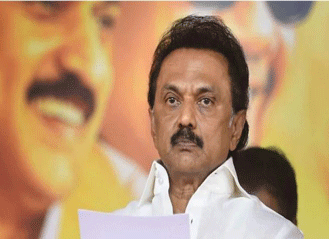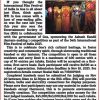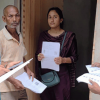Goa is abuzz with excitement as vintage bike and car owners, users, collectors and fans are decking […]

REGIONAL PARTIES POSE CHALLENGE TO BJP!
In the News, June 19- June 25, 2021 June 18, 2021REJECTED: Despite entering into an alliance with the AIDMK which was dominated by the late Jayalalitha, the BJP lost the state to Stalin of the DMK.
By Rahul Verna & Pranav Gupta
In the recently concluded elections to five Assembly seats, regional parties like the DMK in Tamil Nadu, the LDF in Kerala and the Trinamol in West Bengal trounced the BJP. The BJP is also losing its base in the biggest state in the country, Uttar Pradesh, which has 80 parliamentary seats.
Narendra Modi and Amit Shah by far remain the best election team any political party can hope for, but voting patterns have changed in India.
Barely a year since the Bharatiya Janata Party’s losses in Chhattisgarh, Madhya Pradesh and Rajasthan assembly elections, the electoral map of India already looks less saffron.
Despite the BJP’s massive victory in the 2019 Lok Sabha election, the state assembly elections are proving to be a tough contest for the party. It struggled in Haryana, failed to come back to power in Maharashtra, and badly lost in Jharkhand. Notwithstanding these electoral reversals, the BJP’s ideological project remains at its peak, and even the opposition to its politics mirrors in ideas and tactics.
What explains the BJP’s inability to retain power in states and overcome anti-incumbency sentiments? Why is this national party losing state assembly elections? While the specifics of political dynamics vary in each state, four common factors seem to underline the BJP’s underwhelming performance in retaining the states.
Dependence on Modi and Shah
First, the BJP’s over-reliance on Narendra Modi and Amit Shah to win elections is costing it. While the duo by far remains the best election team any political party can hope for, their track record in retaining states has not been great. The Modi-Shah combination worked miracles for the BJP from 2013 to 2018, especially in those states where the party was in opposition.
PM Modi’s charisma helped the BJP add more voters to its base. Amit Shah, with careful micro-management and alliances with regional parties, created unmatched election machinery on the ground. This rapidly expanded the social and geographical footprint of the BJP. By March 2018, the BJP along with allies was ruling in 21 states, roughly 70 per cent of India’s population.
These electoral victories in the past meant that now the BJP is contesting as an incumbent party in most states. In these elections, voters are evaluating and scrutinising the BJP state governments based on their performances and whether they have fulfilled people’s expectations. PM Modi’s personal appeal then has a limited value in state elections.
Moreover, the BJP’s rise as a dominant national party provided an extra muscle to Amit Shah in dealing with the party’s pre-election allies on matters of the seat-sharing and allocation of cabinet portfolios. The BJP was able to clinch power in many states since 2013 because of support from regional parties such as Janata Dal (United), All Jharkhand Students’ Union (AJSU), the Shiv Sena, the J&K Peoples Democratic Party, and the Lok Jan Shakti Party. But now many of these allies have either left the BJP or are unhappy with it. So, now the BJP has been losing election partners in states — take Maharashtra for instance where decades-old alliances have crumbled. In Jharkhand too, the party contested the elections without AJSU and its allies from neighbouring Bihar — JD (U) and LJP.
Maintaining social coalition
Second, there is a limit to the BJP’s strategy of exploiting the wedge between dominant castes and non-dominant social groups in states. The BJP’s electoral success in Haryana, Maharashtra, and Jharkhand in 2014 was attributed to a successful consolidation of non-dominant social groups. For instance, in Jharkhand, a consolidation of ‘upper castes’ and OBC voters led to the party’s victory in 2014. After winning the assembly election, the BJP appointed chief ministers from non-dominant social communities all three states.
Manohar Lal Khattar, a Punjabi Khatri, and Devendra Fadnavis, a Brahmin, became CMs in Haryana and Maharashtra. Similarly, in Jharkhand, the party appointed the state’s first non-tribal as CM – Raghubar Das, an OBC. This gambit of the BJP seems to have invited backlash from dominant groups. A large section among the dominant castes felt excluded from the ruling social coalition and asserted themselves in state elections. These antagonised voters may still vote for Narendra Modi in Lok Sabha elections but not for the state BJP leader.
Strong local face
Third, it has been a common practice within the BJP and the Congress to appoint chief ministers without a mass base. It suits the national leadership in both the parties to have rubber-stamped CMs who are dependent on them for mobilisation. But this strategy is a double-edged sword.
The central leadership of a party cannot always campaign and win elections for its state leadership, especially if the election is being contested on local issues. However, if the state leader develops an independent base for herself, the central leadership becomes insecure.
Electoral contests in India are leader-driven, and Jharkhand CM Raghubar Das lost his own seat by a substantial margin against his former party colleague — Saryu Roy.
Unpopular leaders without a strong voter base are unlikely to win their re-election bid. Narendra Modi, Raman Singh, Shivraj Singh Chouhan and many others within the BJP did start out as top-down appointees, but they built independent support early on in their tenures that greatly helped their re-election campaigns. In Gujarat, Modi’s successors Anandiben Patel and Vijay Rupani fell short of public expectations, and the BJP had to sweat it out during the 2017 assembly elections to hold on to its pocket borough.
The big change in Indian politics
Finally, a big change in Indian politics since the arrival of Modi and the rise of BJP has been the extent of variation in voting behaviour during Lok Sabha and state assembly elections. During the 1990s, state-level dynamics determined voting behaviour during national elections too. Since 2014, there is a national mood during the Lok Sabha elections that dissolves state-specificities, but the same specificities come back with greater vigour during assembly elections.
The BJP, with its centralised leadership and the nationally coordinated campaign, is finding it difficult to break through this emerging divergence in people’s voting preferences.
Can the BJP break this cycle in the near future? The answer lies in whether it manages to overcome these four hurdles.
Rahul Verma is a fellow at the Centre for Policy Research. Pranav Gupta is pursuing a Ph.D in political science from the University of California, Berkeley. Views are personal.
Coutersy:www.theprint.in















